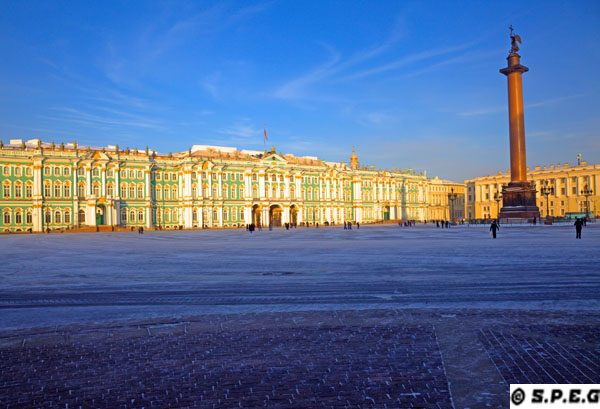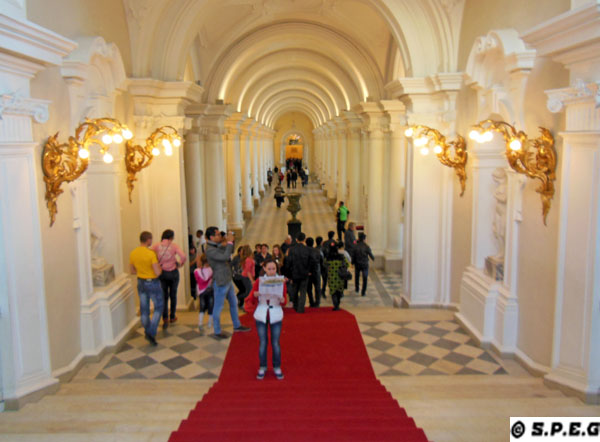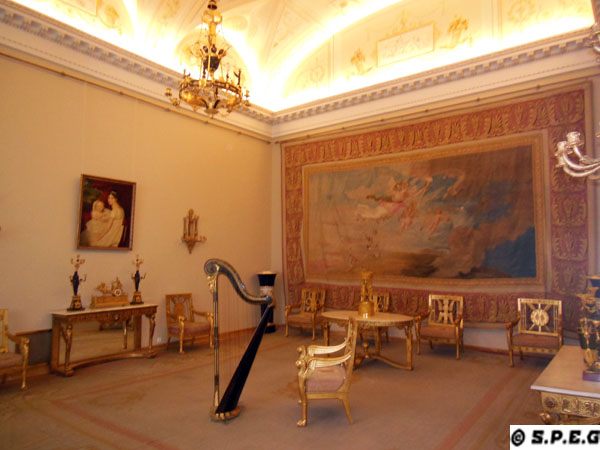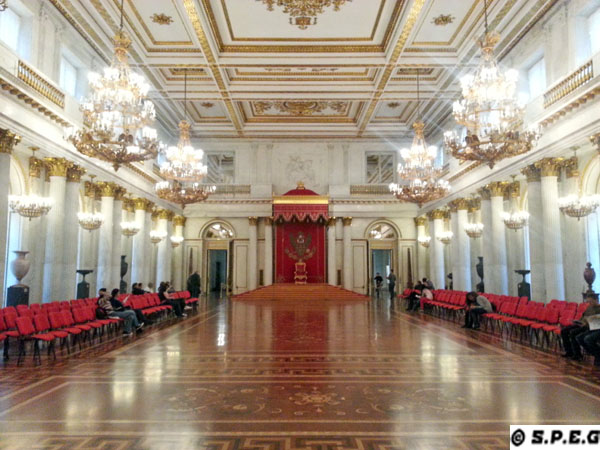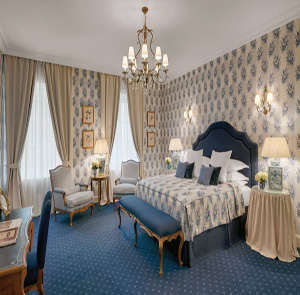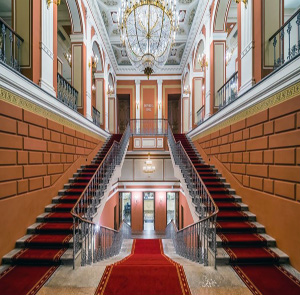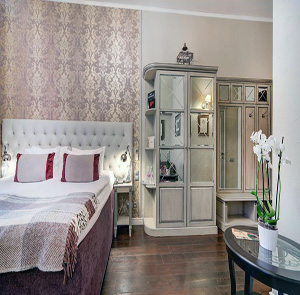THE STATE hermitage museum
THE RICHEST & FINEST
ART MUSEUM IN THE WORLD
The Hermitage museum is a must-see for all first-time travellers to St. Petersburg as is the city's most popular visitor attraction.
Founded in 1764 by Russian Empress Catherine the
Great, the State Hermitage Museum is the richest, finest, and biggest museums in the world. It is a place of great beauty both inside, as it is the home of the city’s Museum of Art and Culture, and outside, because of the architectural grandeur of the buildings that make up the complex.
With over three million works of art and treasures housed in five connected building along the Neva River, the museum can't fail to impress. A tour inside the Hermitage Museum is a unique cultural experience introducing you to the history of art from the 25th century B.C. to the current days.
Viewed from across the Neva River, the buildings could have and can still inspire a variety of emotions: fear and possibly anger in the old days, awe and amazement today. Regardless of the emotions felt, anyone who has seen the complex would have to admit that the buildings are works of art as beautiful as those works found inside the museum.
For your information, the Hermitage Museum complex includes five main buildings: the Winter Palace; the Small Hermitage; the Great (Old) Hermitage; the New Hermitage; and the Hermitage Theatre. Several other buildings are also part of the complex and worth visiting, such as the General Staff Building, the Menshikov Palace, and the Imperial Porcelain Factory.
Walking through the stunning rooms of each exhibition of the Museum is an experience of a lifetime, which should not really be missed. If you are keen to know what you can find inside the Museum before going, then keep reading below.☺
A LOOK INSIDE THE HERMITAGE MUSEUM
Interested to visit the Hermitage Museum? If so, click on the links below or scroll down the page to learn more.
Quick Links:
THE FIVE BUILDINGS
The main displays of one of the world's largest museums are located in five buildings facing the Neva and Palace Square. They form a single palatial main complex that was roughly a century in the making (from 1754 to 1852), and are referred by locals too as "Winter Palace". This main complex is what you see on typical photos of the Hermitage and postcards.
The Winter Palace is a huge three-story Baroque-style building. It contains 1500 rooms, 117 staircases, and a total floor area of about 46,000 square meters. The palace was constructed in 1754-1762 by Bartolomeo Rastrelli for the Empress Elizabeth. In the past, it was a residence of the Russian emperors and the seat of the Russian Provisional Government for a short time following the Revolution of 1917. Some of the magnificent interior features include the Jordan or Ambassador Staircase, the large Throne Room, and the War Gallery of 1812, including the superb Malachite and Gold Drawing Rooms.
The Small Hermitage comprises two pavilions on the north and south that are linked by galleries and Hanging Garden. The architectural design combines features of the Late Baroque and Early Classicism periods of art. This was the original building built during the reign of Catherine the Great. The word “hermitage” means a hermit’s home, but popular parties of Catherine’s time featuring games and performances were known as “small hermitages”. Catherine’s parties were held in the northern pavilion and works of art were displayed in the side galleries. These artworks were the first pieces of the collections of the Imperial Museum.
The Great (Old) Hermitage was put up between 1771 and 1782 to the design of Yury Velten and was built to naturally complete the existing palace ensemble and accommodate Catherine II's collections and libraries. Of the many
amazing rooms inside, the Room of the Italian Renaissance, where the works by Leonardo da Vinci
are displayed, is the most attractive.
The New Hermitage building was designed by Leo Von Klenze, the creator of the Bavarian museum, and constructed to the south of the Great (Old) Hermitage for the Tsar Nicholas I. Inspired by the famous Pinakothek, the pride of Munich, this part of the museum opened in 1852 with 18 impressive halls housing interesting pieces of Ancient Art. For example, one of the halls contains a gigantic vase (4.5 meters in diameter) that was cut from a single piece of Revno Jasper by the craftsmen of the Kolyvan Lapidary Works in the Altai.
The Hermitage Theatre is one of the oldest theatres in St Petersburg and in Russia. Built for Catherine II by Giacomo Quarenghi, the old foundations of the palace are still visible on the ground floor. The theatre is viewed as a rare monument to Catherine’s personal tastes and affections. It features a semi-circular auditorium surrounded by ten niches holding statues of Apollo and the muses and is richly decorated in the Roman style.
Other Branches Of The Hermitage
The Hermitage Museum has also other well known branches worth visiting, such as the General Staff Building, the Menshikov Palace, and the Museum of the Imperial Porcelain Factory.
The General Staff Building is one of the world's largest architectural compositions and, arguably, the finest creation of one of St Petersburg's foremost 19th century architects Carlos Rossi. Located opposite the Winter Palace, across the huge and beautiful Palace square, the building hosts temporary exhibitions about post-impressionist art. A large arched opening separates the east and west wings. The arch is topped by a triumphal chariot.
The Menshikov Palace constructed on the bank of the Neva River is the best and sole-surviving residence of General Alexander Menshikov. Founded in 1710 by Giovanni Mario Fontana, the palace was the first stone building in the city and has been a part of the Hermitage museum since 1981. It has been restored several times over the years, and today it hosts a constant exhibition about the life of early years of the history of St Petersburg.
The Imperial porcelain factory is one of the oldest factories in Russia producing ceramic porcelains. Today it also houses exhibitions about the history of porcelain, which consists of more than 30,000 items including porcelain, glass, drawings, photographs and rare publications.
the hermitage displays
The Hermitage Museum is home to one of the most significant art collections in the world (numbering around 3 million items), presenting the history of art from the Egyptian and Roman times, way through Medieval and Renaissance times up until the classical modern period and the present. Most famous are the displays of Western European art and the Treasure Gallery. But there is more, so keep reading below!
If you are wondering what type of collections you may find inside the museum, below is a short summary of the most interesting exhibitions currently on display.
- Ancient Cultures of Eastern Europe, Siberia, Central Asia, the Caucasus and Transcaucasia - An introduction to the ancient history of territories in which the foundations of a number of present-day civilizations were laid.
- Western European Arms and Armour of the 15th to 17th Centuries - Hall 243, better known as the Knights' Hall, contains Western European arms and armor from the imperial collection (one of the largest in the world with some 15,000 items.
- Western European Art of the 13th to 19th Centuries - This is the largest display in the museum, the most famous, and probably, most valuable to see. It includes masterpieces by Giorgione, Leonardo da Vinci, Raphael, Rembrandt, Van Dyck, Rubens, Hals, Cranach, Velazquez, Gainsborough and other great masters of world art.
- Art of Ancient Egypt and the Middle East - The display occupies two halls on the ground floor, accessible by way of the Eastern Vestibule. Here are unique cultural artifacts from the states that formed in the Nile valley and between the Tigris and Euphrates in the 4th to 2nd millennia B.C.
- Art of Iran and the Middle East - Presents pre-Islamic and medieval art of a region from which in the era
of the Crusades the cultural achievements of eastern civilizations
flooded into Europe.
- Art of the Ancient World - The collection numbers over 113,000 items, representing the art of
Ancient Greece, Etruria, Roma and the Hellenic colonies of the northern
Black Sea Coast.
- The Treasure Gallery - the basis of the display is the priceless Siberian Collection of Peter
the Great and unique artifacts from Scythian burial mounds. Here too are
precious gifts made for the Russian rulers, including items from the
legendary treasury of the Great Moguls.
must-see collections
With over 30.000 exhibits on display you can easily get a sense of overload and feel lost, if you visit the Hermitage museum unprepared. If you would like to know what to skip and what to keep during your visit at the Hermitage Museum take note of our hand-picked list of must-see collections below. Come prepared and you will have fun!☺
- The St George Hall also known as the Large Throne Room - This is one the largest state rooms in the Winter Palace approached by the main Jordan staircase, originally created to host palace ceremonial, and other royal events.
- The Hall of Italian Renaissance - The hall is dedicated to Italian art of the 16th-18th centuries on the first floor in the New Hermitage, which occupies the Small and Large Italian Skylight Halls.
- The Peter the Great Hall - This is one of the best room of the Hermitage museum dedicated to the memory of Peter the Great.
- The Gold Drawing Room - Along with the White Hall, the Green Dining-Room, the Crimson Study, the Boudoir and the Blue Bedroom, the Gold Drawing-Room offers an interesting exhibition of the private rooms of Empress Maria Alexandrovna.
- The Hall of Egyptian Art - The room display a wide range of masterpieces of Ancient Egyptian art.
- The Malachite Room - This is a beautiful room decorated with semi-precious stones from the Urals. Columns, pilasters, fireplaces and tables are faced with malachite in the technique of Russian mosaics.
- The Gallery of 1812 - The room display 332 portraits of Russia's victory over Napoleonic France.
- The Armorial Hall - Created for grand receptions, the room display Western European silver and several sculptural groups of early Russian warriors.
- The Pavillion Hall - Created in the middle of the 19th century, the Pavilion Hall in the Small Hermitage museum is the most popular with visitors because of its striking architecture.
- Raphael Loggias - The hall offers a nice narrow gallery whose east side overlooks the Winter Canal and the Hermitage Theatre.
where to BUY tickets
The ticket office for the Hermitage Museum can be found inside the main building. Just walk through one of the three big arches facing Palace Square, then move all the way through the courtyard and enter the building through one of the two sides of the main entrance. You will see a big reception where you can ask questions and buy your tickets.
You can also buy tickets at the Hermitage Museum Official Hotel. The biggest advantage of staying there is that you can buy your ticket in the lobby and save a lot of time at the museum. The hotel also provides a shuttle service to and from the museum twice a day, which is not bad!
Alternatively, you can also buy tickets online via the museum official website (highly recommended). Lastly, if buying tickets online is not an option for you, then you can even take advantage of a couple of self-service ticket machines in the courtyard before the main entrance.
how to get there
The Hermitage museum is located in the heart of the city aside the famous avenue Nevsky Prospekt. Thus, if you are staying nearby Nevsky Prospekt you can easily reach the museum on foot. Otherwise, if you cannot walk you can take any local bus going down to the Palace embankment. If you have a smartphone, download the app 2GIS. You can type in your location and that of the Hermitage, and it will give you some public transportation options.
practical information
Address: 2, Dvortsovaya Ploschad (Palace Square)
Metro: Admiralteyskaya
Open: Daily 10:30 am to 6 pm. Last admission is at 5:30 pm. Wednesday and Friday, till 9 pm. Last admission is at 8:30 pm.
Closed: Monday
Telephone: +7 (812) 571-3420; +7 (812) 710-9079
Website: http://www.hermitagemuseum.org/
Admission: 600 Rubles - entry ticket to the Main Museum Complex and the branches (the General Staff Building, Winter Palace of Peter the Great, Menshikov Palace, the Museum of the Imperial Porcelain Factory). 300 Rubles - entry ticket to one of the Hermitage branches (Winter Palace of Peter the Great, Menshikov Palace, the Museum of the Imperial Porcelain Factory, Staraya Derevnya Restoration and Storage Centre). Audio-guides are available (deposit required)
Free admission: Preschool children, school children, students. Free admission to all visitors on the first Thursday of each month.
Photo and video: No flash.
Accessibility note: The museum is wheelchair accessible (ramps/lifts). Free wheelchair rentals. Please call in advance as staff assistance may be required
*For more information please visit the official website.
tips & recommendations

With over 1000 rooms, the Hermitage Museum is the most confusing to find your way around. For this reason we recommend that you hire a local tour guide to save time and nerves. If this is not an option for you, then get a map and/or an audio guide before entering the museum.
- You should know that there are often queues at the entrance both to get in and to buy a ticket. Thus, if you want to skip long ticket-office queues we recommend that you buy tickets online beforehand, or much better, you hire a local tour guide. He or she will take care of all your entrance tickets and greatly add to the experience - plus he or she will know what to see in the allocated time (and what not).
- Give yourself plenty of time to visit the museum and try to go on weekdays to avoid the crowds.
- The first Thursday of every Month entry is free. So if you tour on your own, plan your visit around these dates. And, if you go on this day, make sure you arrive early in the morning (around 9 AM) to avoid long queues.☺
- The best time to visit the Hermitage Museum is definitely in winter because there are only a few tourists around. Summer (from May to September) is considered high tourist season, so the crowds are at their thickest.
- If you come from late May to early September, keep in mind that in order to skip the cruise ship crowds, avoid mornings altogether, unless you are part of an organized group.
- Usually the majority of the tour groups start touring in the morning. So if you come
to the museum after 3 pm or 4 pm on Wednesday, you'll have a better
chance of less crowds.
- For your information, the Hermitage Museum is open on Wednesday till 9
pm, but only in summer.
- A full day is required to see some of the best art collections of the museums. However, spending an entire day at the Hermitage Museum can be also a challenge and very tiring. So we recommend splitting your visit over 2 days. Simply buy a two-day ticket online in advance and divide your time over a couple of days rather than trying to cram it all into a one-day visit. Plus, two-day tickets include admission to several additional Hermitage-run buildings like the Menshikov Palace and the Winter Palace of Peter the Great.
- Remember that you are not allowed to touch anything or to take photos inside the Hermitage Museum or its branches. If you want to take pictures or video, just pay the extra fee charged at the museum at the same time you are buying the tickets. Please note that photo can be taken but without a flash.
- When visiting the museum avoid wearing shorts and T-Shirts, plus remember that smoking and chewing gums is strictly forbidden.
- Usually four hours is probably an absolute minimum of time to spend there if you want to see the main state rooms and some of the most popular artworks.
- Keep in mind that ticket sales ends an hour before the museum closes.
- Remember, when you buy tickets online, the tickets are automatically inclusive of the photo fee.
- No large bags, backpacks or suitcases are allowed inside the museum. So be prepared to leave them in the cloakroom.
- Be aware that drinking and eating inside the halls and galleries of the Hermitage museum is not allowed. If
you need a break during your visit, you can use the on site cafe, which serves reasonably good snacks and drinks.
accommodation near the hermitage museum
Our picking list of hotels in the heart of Saint Petersburg
must-have travel resources
Our picking list of essentials travel resources for your trip to Russia
LOOKING FOR A PRIVATE TOUR?
Book a guided city tour with one of our professional tour guides, and get the most out of your visit to Saint Petersburg, and beyond.
From the Hermitage Museum return to St Petersburg Attractions or go to the Homepage
DO YOU LIKE ST PETERSBURG ESSENTIAL GUIDE? HAVE YOU FOUND THIS PAGE HELPFUL?
If you do, please help others to find out about it. If you have a blog or website, or know someone who does, consider linking to us. Share the link on Facebook, Tweet it... you get the idea. Every link helps!
